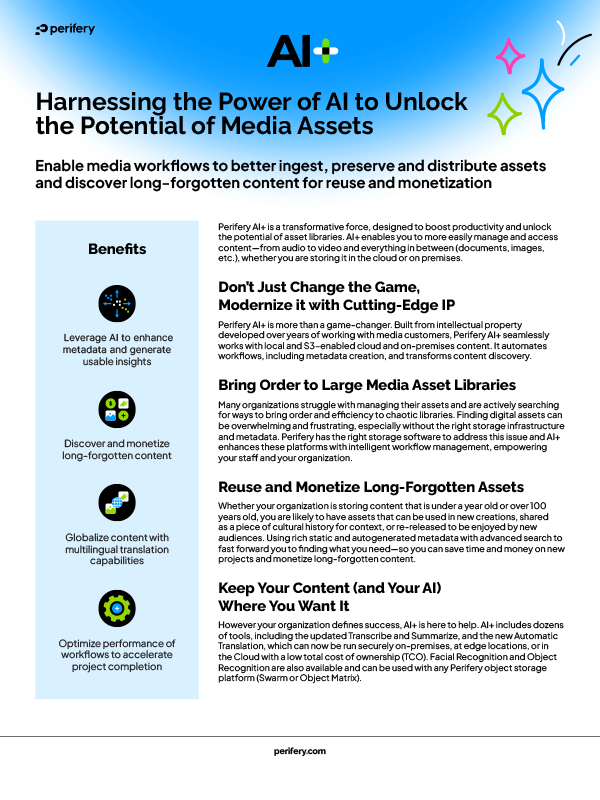
LTO has long been the workhorse of media archive platforms, serving as the go-to solution for organizations looking to preserve their valuable content. However, the limitations of LTO solutions means they can no longer keep pace with the industry’s shifting demands and dynamics. Issues ranging from access speed to compatibility concerns are driving the migration away from outdated storage methods to more modern, versatile, and future-proof architecture.
The rigid compatibility of LTO has been a constant source of frustration for media professionals. It was designed in a different era, when demands on media archives were vastly different to what they are today. And while the capabilities have evolved since the release of the first generation LTO (LTO-1) in 2000, the technology hasn’t managed to adapt at the same pace as storage alternatives.
Some of the challenges of LTO include:
- Tech lock-in: LTO providers often lock users into one workflow. One way in, one way out. This prevents the content from being used in other workflows or being shared with other departments. This type of LTO-driven workflow essentially creates a content jail.
- Accessibility limitations: LTO systems put barriers in front of data-driven teams. Not only is it a lengthy process to search and retrieve assets, it’s also difficult to share content with others.
- Incompatibilities: Inflexible compatibility policies between versions (e.g., LTO-9 isn’t compatible with LTO-6) means that organizations are forced to migrate to or maintain various generations of tape readers. Likewise, LTO products aren’t cross-compatible with non-LTO items.
- Resource requirements: Managing LTO libraries requires physical resources, both in terms of storage space and personnel. These lead to financial implications; maintaining LTO demands a higher operational expenditure.
- Responding to audience demands: Effective audience or fan engagement strategies require content, new and old, to be available at your fingertips. Broadcasters want to share their 40-year-old archives with their digital consumers but cannot as content is locked in proprietary LTO silos.
As a result, LTO, once a reliable archive solution, is facing rapid decline as organizations increasingly turn to cloud and hybrid workflows powered by object storage to overcome the barriers to their content. With changing business requirements, there are many reasons why organizations might look to replace their LTO infrastructure. We’ve outlined 7 of the top reasons media teams are modernizing their archive platforms.
1. Faster access to the whole archive
The media and entertainment industry operates in a real-time world where opportunities have to be seized to gain the competitive edge. Producers need self-serve access to archive content to meet often very short deadlines with quick turnarounds. Cloud-based storage provides media teams with instant, unlimited self-serve access to content from anywhere and at any time.
2. Interoperability
Working with a diverse set of tools, media professionals require solutions that seamlessly integrate with one another to maintain continuity and consistency. Cloud storage solutions facilitate cohesive workflows, allowing data to travel seamlessly across various platforms, and eliminating any compatibility issues.
3. Versatility
The multifaceted nature of the M&E industry demands solutions that can adapt to changing workflow requirements without causing disruption. Cloud storage delivers the versatility needed to allow media professionals to seamlessly store, manage, and access an extensive range of media assets.
4. Efficiency
Legacy storage systems often rely on manual resources and intervention and add complexities where there shouldn’t be any. Cloud storage provides a highly efficient and automated framework, allowing media teams to tag, search, and retrieve content without delay.
5. Future-proof
The M&E industry can change rapidly – from new technology innovations to distribution channels to consumer trends – so the ability to adapt and scale is crucial. Cloud-based storage solutions are designed with the future in mind. Whether you’re integrating AI or upgrading content resolutions, the agility offered through the cloud ensures organizations are equipped for any future technological changes.
6. Content integrity
Ensuring the integrity of content is non-negotiable in the world of M&E. Cloud storage provides a secure and resilient environment for valuable media assets. With its built-in redundancy, replication, and back-up, content remains safeguarded, preserved, and accessible.
7. Metadata awareness
With more data generated and stored than ever, ensuring assets can be found within your storage system is essential. Cloud storage offers advanced metadata management and awareness, allowing media pros to efficiently organize, locate, and retrieve content. This functionality is crucial for data-driven organizations to repurpose and re-monetize their content.
Largely speaking, organizations are realizing that their content needs mobility so it can be exploited, shared, re-used, or moved to new platforms. LTO storage is largely considered an outdated technology for media companies wanting to improve their business, financially and operationally.
If you’re looking to migrate to a more flexible, modern, and future-proof, archive platform, or augment your existing LTO infrastructure, get in touch with the Perifery team.
